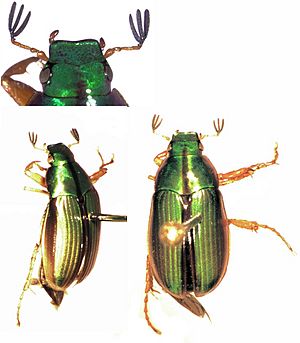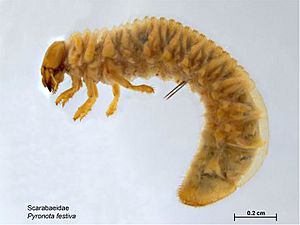Manuka beetle facts for kids
Quick facts for kids Manuka beetle |
|
|---|---|
 |
|
| Pyronota festiva male | |
| Scientific classification | |
| Synonyms | |
|
The Pyronota festiva, also known as the manuka beetle or manuka chafer, is a type of beetle. It belongs to the Scarabaeidae family, which includes many kinds of beetles. This beetle is special because it is only found in New Zealand. You can often spot it on manuka trees (Leptospermum scoparium), which is how it got its name. In some places, people see it as a farm pest.
Contents
What Does the Manuka Beetle Look Like?
The manuka beetle is usually bright green. It can also have hints of blue and yellow on its back. A dark stripe, often brown or yellow, runs down the middle of its hard wing case. These beetles can be anywhere from 3mm to 25mm long. However, most of them are about 9mm long.
Body Features
Manuka beetles are part of a group called Scarabaeoidea. They have a special front body part called a prothorax. Their legs are quite thin and covered in light-colored hairs. These legs are good for digging. Their antennae are unique, shaped like small clubs that can fold tightly.
As larvae, which are like beetle grubs, they look like a C-shape. Their bodies are stout and shiny.
Where Do Manuka Beetles Live?
The manuka beetle lives only in New Zealand. There is no strong proof that it lives anywhere else. However, it is related to other beetles like chafers and grass grubs. These relatives are found in many parts of the world.
Manuka Beetles in New Zealand
Manuka beetles are very common across New Zealand. They live in grassy areas and other plant habitats. This covers most of New Zealand's landscape. Because there are so many, they can become a problem for farms.
They have been seen in the North Island, especially near Egmont National Park. Here, their larvae eat the roots of plants. This can cause damage to pastures.
Where They Like to Live Best
Manuka beetles can live in many different places. But they really like areas with woody plants. They are often found in tussock grass and pastures. These are areas that used to be native bush. As their name suggests, they prefer to live in the soil around manuka trees. Adult beetles are often seen flying around the small white flowers of manuka trees in summer.
Life Cycle of the Manuka Beetle
Manuka beetles usually have a two-year life cycle. They spend two winters as larvae, which are like grubs. Then, they grow into adult beetles during the summer, from November to January. Warmer weather makes the beetles more active. This also helps their populations grow. Adults are more active when the sun is shining.
Stages of Life
The life cycle has three main larval stages. Eggs are laid in January. The young larvae spend their first winter underground. They spend their second winter as larger larvae. If conditions are good, they complete their full two-year cycle. Sometimes, they can develop faster, even in one year.
During the larval stage, they are considered a minor pest. The larvae hatch and become pupae. They eat the roots of plants in the soil. As they grow, they form a C-shape. In early summer, they come out of the soil as full-grown beetles. They then feed on the leaves of manuka plants. The damage from the larvae eating roots becomes clear in autumn and winter.
Adult beetles are only around for a few weeks each year. This is usually in late spring and early summer. They fly when it is warm during the day. Female beetles lay their eggs in pasture soil, up to 10 cm deep. Each female can lay 30 to 40 eggs at once. If there are too many beetles, like 350 per square meter, they can cause a lot of damage. You might see yellow, dried-out patches of grass.
The manuka beetle's life cycle is a bit different from its relatives. Its eggs are laid in the soil. The larvae develop underground for a long time. Adult beetles die soon after mating. Their bodies can sometimes form piles near mud or tree roots.
What Do Manuka Beetles Eat?
The larvae of the manuka beetle eat the roots of plants. If the eggs were laid near a manuka tree, the larvae will eat its roots. They also eat the roots of other plants like matagouri and sweet briar roses. Most larvae are found eating in the top 4 cm of soil.
Adult beetles eat the leaves of the manuka tree. They also eat grass roots in farm areas. This is why they are a problem for farmers. They harm the grass that cows eat.
Who Are Their Predators?
Adult manuka beetles are green. They are active during the day. This helps them hide from predators because they blend in with plants. Some animals that eat manuka beetles include mice, gulls, and house sparrows.
Mice and Birds
Studies on Mokoi Island showed that house mice eat manuka beetles. The beetles are an important food source for them. Red-billed gulls also eat manuka beetles. They are often seen flying over farms at sunset to catch them. This happens more in autumn and winter. During these seasons, beetles are less likely to fly. They are also more exposed when they come to the surface from wet pastures.
House sparrows also eat manuka beetles. They feed them to their chicks. Manuka beetles are also a food source for trout fish.
Controlling the Beetles
Since manuka beetles can be pests, scientists are looking for ways to control them. They are studying bacteria and fungi that can harm the beetles. These are called 'bio-control' methods.
One type of bacteria, Rickettsiella, is being studied. It causes an infection in the beetles. A fungus called Beauveria brongniartii is also being tested. It causes many larvae to die. This fungus mostly affects certain types of beetles. This means it is less likely to harm other helpful beetles.
How People Have Used Manuka Beetles
The native Māori people of New Zealand used manuka beetles in several ways. Piles of dead adult beetles would form in shallow water or mud. Māori often collected these and ate them as a special food. They also ate other insects like the 'huhu grub'.
Manuka beetles were also used for medicine. They were thought to have antiseptic qualities. They could also help with fevers and stomachaches.
Manuka Beetles and Fishing
Manuka beetles are more active during the day in November and December. Strong winds can blow them onto the surface of the water. Trout fish wait in the water for the beetles to land. Beetles have been found in the stomachs of trout in Lake Tikitapu. This shows that trout eat them.
Fishermen have even made a special fishing fly called the 'green beetle'. It looks like a manuka beetle. It is designed to help catch trout during the summer.
Cool Facts About Manuka Beetles
Manuka beetles can cause damage to fruit trees like peaches and nectarines. This is surprising because they are usually linked to native grasses and farms. They can harm both the leaves and the fruit.
Full-grown beetles eat manuka plants. These plants have an oil that makes the beetle's outer shell very hard. This hard shell also has special layers inside. When you look at them under a microscope with light, these layers create shiny, metallic green reflections.
Farmers can control manuka beetles using a method called 'hoof and tooth'. If many farm animals are kept in a pasture during winter, when the soil is wet, their hooves can crush the beetle larvae. This can greatly reduce the number of beetles.


